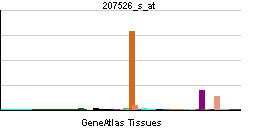Entrez 9173 | Ensembl ENSG00000115602 | |
 | ||
Aliases IL1RL1, DER4, FIT-1, IL33R, ST2, ST2L, ST2V, T1, interleukin 1 receptor like 1 External IDs MGI: 98427 HomoloGene: 2862 GeneCards: IL1RL1 | ||
Interleukin 1 receptor-like 1, also known as IL1RL1 and ST2, is a protein that in humans is encoded by the IL1RL1 gene.
Contents
Function
IL1RL1 is a member of the Toll-like receptor superfamily based on the function of its intracelluar TIR domain, but its extracellular region is composed of immunoglobulin domains. Unlike other members of the family IL1RL1 does not induce an inflammatory response through activation of NF-κB, although it does activate MAP kinases.
ST2 is a member of the interleukin 1 receptor family. The ST2 protein has two isoforms and is directly implicated in the progression of cardiac disease: a soluble form (referred to as soluble ST2 or sST2) and a membrane-bound receptor form (referred to as the ST2 receptor or ST2L). When the myocardium is stretched, the ST2 gene is upregulated, increasing the concentration of circulating soluble ST2. The ligand for ST2 is the cytokine Interleukin-33(IL-33). Binding of IL-33 to the ST2 receptor, in response to cardiac disease or injury, such as an ischemic event, elicits a cardioprotective effect resulting in preserved cardiac function. This cardioprotective IL-33 signal is counterbalanced by the level of soluble ST2, which binds IL-33 and makes it unavailable to the ST2 receptor for cardioprotective signaling. As a result, the heart is subjected to greater stress in the presence of high levels of soluble ST2.
Molecular biology
The gene is found on the long arm of Chromosome 2 (2q12). It is 40,536 bases long and is located on the Watson (plus) strand. It encodes a protein of 556 amino acids (molecular weight 63,358 Da). Both membrane bound and soluble forms are known. The protein is known to interact with MyD88, IRAK1, IRAK4 and TRAF6. It appears to be essential for the normal function of T helper cells type 2 (Th2 cells) .
Clinical significance
Mutations in this gene have been linked to atopic dermatitis and asthma.
The protein encoded by this gene serves as a cardiac biomarker.
